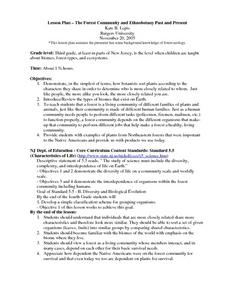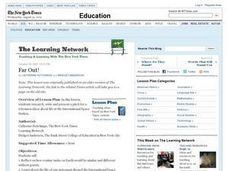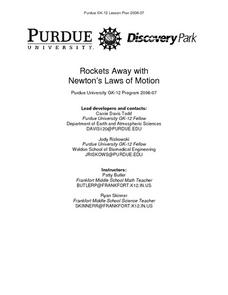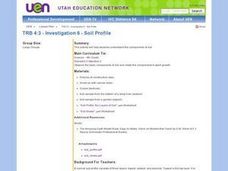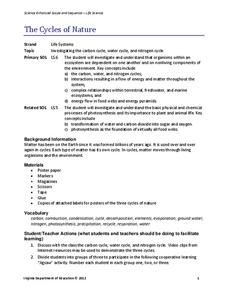Curated OER
Wonderful Worms
Students identify living and non-living things and explain the importance of earthworms to the soil. They name some basic facts about earthworms, recognize basic worm vocabulary words and demonstrate vermicomposting techniques.
Curated OER
Fighting Back!
Fifth graders inspect the basic functions of the immune system and determine how viruses and bacteria invade the immune system. They also explore what happens to the immune system in outer space.
Curated OER
The Forest Community And Ethnobotany Past And Present
Students describe a forest as a living community. They determine members interact, and in many cases, depend on each other for their basic survival needs. They investigate how dependent the Native Americans were on the forest...
Curated OER
Far Out!
Students research and compare/contrast how routine tasks on Earth would be without gravity. They read and discuss the article "The Life Galactic: A Lot of Work, a Little Play, Plenty of E-Mail." In groups they write a pitch for a TV...
Curated OER
The Cool Forms of Water
Students discover the different forms of water on Earth. In this states of water instructional activity, students read material on the different forms of water and how they are created. The students answer written questions on worksheets.
Curated OER
Rockets Away with Newton's Laws of Motion
Eighth graders comprehend Newton's Laws of Motion and to use the scientific method in rocketry sub-unit. They work through the scientific method. Students illustrate how science and Newton's Laws can be used in everyday situations and...
Curated OER
Dinosaurs 1: Where Are the Dinosaurs?
Students study dinosaurs. In this dinosaur instructional activity, students watch a web based video about dinosaurs before discussing what they liked about the dinosaurs, telling about the sounds they heard, and explaining what the Earth...
Curated OER
Black Holes Revealed
Students explore the concept of black holes through an interactive program. They explore how they form and what materials form them. They can also visit websites in which they can research radio transmission between the Earth and space.
Curated OER
Density Challenge
Students calculate the densities of several liquids that appear similar. In this physical science lesson, students go beyond understanding the way liquids of different densities behave to researching how this knowledge applies in real...
Curated OER
Investigation 6 - Soil Profile
Fourth graders study the components of soil. They observe the basic components of soil and relate the components to plant growth. They record color, texture, and kinds of materials on their profile log (light color, denser, grittier -...
Curated OER
Math Skills-Writing Scientific Notation
In this scientific notation worksheet, students perform basic math functions and express their answers in scientific notation.
Curated OER
How to Balance Equations for Oxidation-Reduction Reactions
In this balancing oxidation-reduction reactions, students learn how to assign oxidation numbers to atoms in compounds, they learn how to write half reactions in order to balance oxidation-reduction reactions in acidic or neutral...
Curated OER
The Discovery of Photosynthesis
Young scholars explore how scientists discover photosynthesis. In this biology lesson plan, students identify the basic requirements for photosynthesis to happen. They recreate past scientists' experiments and record their observations.
Curated OER
Jupiter
A student-produced PowerPoint provides basic facts about the planet of Jupiter. Illustrated slides highlight its physical attributes and satellites. A lot of interesting information about Jupiter is included, such as the fact that twenty...
Curated OER
The Basics of Creature Connectedness: Biodiversity Diversions
Learners study biodiversity. They participate in a scavenger hunt to look for presence of wildlife and connections in nature. They create a collage about Venezuelan biodiversity in small groups and present to the class. They write a...
Curated OER
Feeling Hot, Hot, Hot!
Students study the different types of volcanoes and how they erupt. In this volcano lesson plan students identify where volcanoes are most prevalent and options for predicting eruptions.
Curated OER
This House is Made of Mud: Exploring the Shapes in Our Lives
Students study about our dependence on the earth's resources for materials. They practice their knowledge of geometric shapes by recognizing them in the context of the story.
Virginia Department of Education
The Cycles of Nature
Encourage peer collaboration and assist with the creation of visual aids to identify carbon, water, and nitrogen cycles as your class learns more about nature. They discuss relative information, create a visual aid depicting the chosen...
Curated OER
Viruses, Bacteria, Protists, and Fungi
In this viruses, bacteria, protists, and fungi activity, students will review the basic characteristics of each of these groups. Students will complete 7 fill in the blank questions about viruses, 6 true or false questions about...
Space Awareness
What is Time?
Does it ever seem like time is slipping through your fingers? Model the passing of time with an hourglass activity in which individuals determine whether hourglasses are the most efficient way to measure time.
Curated OER
Learning About Trees
Students identify the parts of a tree. In this earth science lesson, students draw a tree on construction paper and label the parts of the tree.
Curated OER
Sizing Up the Supersize Croc
Learners examine and compare traits of humans and crocodiles. In this crocodile lesson students use a ratio to estimate the height of a person and compare that to a crocodile.
Curated OER
Climate Change: Is there a Controversy
Students explore climate changes. For this climate changes lesson, students research what causes changes. Students search the Internet, summarize reports they find and create a poster with the information.
Curated OER
Greenhouse Gases: The Chemistry Behind the Culprits
Ninth graders investigate the effect of different gases in the atmosphere. In this chemistry lesson plan, 9th graders explain how these gases contribute to global warming. They suggest possible solutions to this growing problem.




